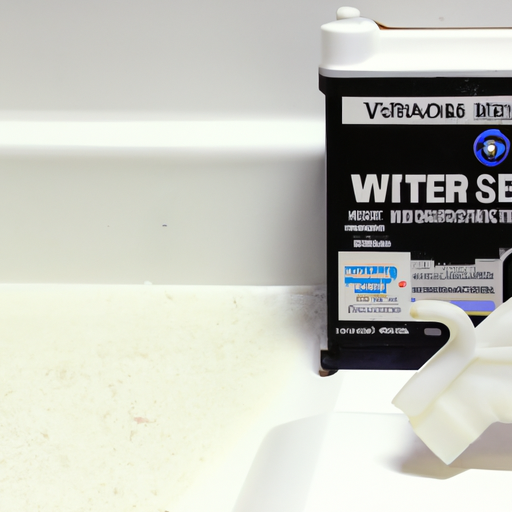You probably never stop to think about it, but your water softener and treatment system are hardworking appliances that require regular maintenance to keep them running efficiently. From checking the salt levels to cleaning the resin tank, taking care of your water softener ensures that you have soft and clean water flowing through your taps. In this article, we will explore the essential maintenance guidelines for water softeners and treatment systems, giving you the knowledge and tools to keep your system in tip-top shape. Whether you’re a long-time owner or just starting out, these guidelines will help you maintain the longevity and performance of your water treatment system.
Regular Maintenance
Cleaning
Regular cleaning is essential for maintaining the optimal performance of your water softener system. Over time, mineral deposits and debris can build up, affecting the efficiency of the system. To clean your water softener, start by turning off the power and closing the water inlet valve. Then, remove the control valve cover and inspect for any visible blockages or dirt. Use a soft brush or cloth to gently clean the valve, making sure to remove any residue. Finally, rinse the valve with clean water and reassemble it.
Resin Bed Maintenance
The resin bed is the heart of your water softener system, responsible for removing minerals that cause hardness. Regular maintenance of the resin bed is necessary to ensure the longevity and effectiveness of your water softener. Resin bed cleaning should be performed annually or as recommended by the manufacturer. To clean the resin bed, follow the instructions provided by your water softener’s manufacturer. This usually involves flushing the system with a specialized resin bed cleaner to remove any accumulated sediments or iron deposits. In some cases, resin bed replacement may be necessary if the resin beads are damaged or worn out.
Brine Tank Maintenance
Brine Tank Cleaning
The brine tank is where the regeneration process takes place in your water softener. Over time, salt residue and other impurities can accumulate in the tank, impairing its functionality. Cleaning the brine tank regularly is crucial to avoid clogs and ensure the proper functioning of your water softener. To clean the brine tank, start by completely draining all the water and removing any remaining salt. Then, using a mild soap or detergent solution, scrub the inside of the tank with a brush or cloth. Rinse thoroughly with clean water and refill the tank with salt before restarting the water softener system.
Control Valve Cleaning
The control valve is responsible for regulating the flow of water and managing the regeneration process in your water softener. Regular cleaning of the control valve is necessary to prevent any malfunctioning and maintain the efficiency of the system. To clean the control valve, turn off the power and close the water inlet valve. Remove the control valve cover and inspect for any visible dirt or debris. Clean the valve using a soft brush or cloth, ensuring that all parts are thoroughly cleaned. Rinse with clean water and reassemble the valve before turning the power back on.

Salt Maintenance
Type of Salt
Choosing the right type of salt is crucial for the proper operation of your water softener. There are various types of salt available, including rock salt, solar salt, and evaporated salt. It is recommended to use high-quality salt specifically designed for water softeners to ensure optimal performance and prevent any potential issues.
Salt Level Check
Regularly checking the salt level in your water softener’s brine tank is essential to maintain its effectiveness. The salt level should be maintained above the water level to ensure continuous regeneration. Most water softener systems have a salt level indicator to help you monitor the salt levels. It is advisable to check the salt level at least once a month and refill the tank as needed to avoid salt depletion.
Salt Bridges
Salt bridges occur when a hardened layer of salt forms on top of the water in the brine tank, preventing the salt from dissolving and affecting the regeneration process. To prevent salt bridges, it is crucial to periodically check the tank and break up any hardened salt. You can use a broom handle or a long utensil to gently break the salt bridge and ensure uninterrupted water softening.
Salt Mushing
Salt mushing is the formation of a thick layer of sludge at the bottom of the brine tank. This can impair the flow of brine and affect the efficiency of the regeneration process. To prevent salt mushing, it is important to clean the brine tank regularly and avoid adding too much water or salt to the tank. Regular maintenance and proper salt dosage will help prevent salt mushing and maintain the effectiveness of your water softener.
Control Valve Maintenance
Timer Settings
The timer settings on your water softener’s control valve determine when the regeneration process occurs. It is important to set the timer settings correctly according to your household’s water usage and hardness level. Consult the user manual or contact the manufacturer to determine the appropriate timer settings for your specific water softener model. Regularly review and adjust the timer settings as needed to ensure optimal performance.
Sensor Calibration
Some water softener systems are equipped with sensors to monitor water flow, salt levels, and other parameters. These sensors ensure the proper functioning of the system and trigger regeneration when necessary. Regular calibration of the sensors is essential to maintain accurate readings and prevent any system errors. Refer to the user manual or contact the manufacturer for specific instructions on how to calibrate the sensors of your water softener system.

Drain Line Cleaning
Regular Cleaning
Regular cleaning of the drain line is important to prevent any blockages or disruptions in the water softener’s regeneration process. To clean the drain line, start by disconnecting it from the control valve and removing any accumulated debris or sludge. You can use a plumber’s snake or a high-pressure stream of water to clean the drain line thoroughly. Ensure that the drain line is reconnected securely after cleaning to avoid any leaks or malfunctions.
Unclogging
In case of a clogged drain line, there are a few steps you can take to unclog it. First, try using a plumber’s snake or a long, flexible brush to dislodge the blockage. If the clog persists, you can try pouring a drain cleaner solution down the line and letting it sit for the recommended time. Afterward, flush the drain line with clean water to remove any remaining debris. If the clog still persists, you may need to seek professional assistance to avoid any further damage to the water softener system.
System Inspections
Annual Check-up
An annual check-up of your water softener system is essential to ensure its proper functioning and longevity. It is recommended to schedule a professional inspection at least once a year. During the inspection, a qualified technician will thoroughly examine the system, check for any leaks, test the water quality, and make any necessary adjustments or repairs. Regular system inspections will help identify any potential issues early on and prevent costly repairs in the future.
Leakage Inspection
Regularly inspecting your water softener system for leaks is important to avoid any water damage and ensure its proper functioning. Check for any signs of moisture or water accumulation around the system, especially around the fittings and connections. If you detect any leaks, immediately turn off the water supply and contact a professional for repair.
Water Analysis
Water analysis is a crucial part of maintaining your water softener system. Regularly testing the water quality will help determine if the system is effectively removing minerals and maintaining soft water. Test kits are readily available and easy to use. Follow the manufacturer’s instructions to collect water samples and analyze them for hardness and mineral content. Based on the test results, you can make any necessary adjustments to the water softener system and ensure a continuous supply of high-quality, softened water.

Vents and Air Gap Maintenance
Vent Cleaning
The vents in your water softener system allow for the release of excess air and gases during the regeneration process. Regularly cleaning the vents is important to ensure proper airflow and prevent any obstructions. Use a soft brush or cloth to remove any dust or debris from the vents, ensuring that they are free from any blockages. This simple maintenance task will help maintain the efficiency of your water softener system.
Air Gap Check
The air gap is an important component of your water softener system, preventing any backflow of wastewater into the potable water supply. Regularly examining the air gap is crucial to ensure its proper functioning and compliance with local plumbing codes. Check for any signs of blockages or leaks in the air gap, and if any issues are detected, consult a professional to address them promptly.
Brine Tank Maintenance
Overfill Prevention
In some cases, the brine tank can overfill due to a malfunctioning float valve or control valve. To prevent overfilling, regularly check the water level in the brine tank. If the water level is constantly rising, there may be an issue with the float valve or control valve. Contact a professional to inspect and repair the faulty components to avoid any potential water damage.
Tank Sanitization
Sanitizing the brine tank periodically is important to prevent the growth of bacteria or algae. Follow the manufacturer’s instructions for proper sanitization procedures, as they may vary depending on the type of tank and water softener system. Typically, a mixture of bleach and water is used to disinfect the tank. After sanitization, thoroughly rinse the tank with clean water to remove any traces of bleach before refilling it with salt.
Troubleshooting Tips
Soft Water Quality
If you notice a decrease in the quality of your soft water, there may be a few potential causes. First, check the salt level in the brine tank and ensure that it is above the water level. Low salt levels can result in insufficient regeneration and compromised water softening. If the salt level is adequate, the resin bed may need cleaning or replacement. Contact a professional to assess the resin bed and perform any necessary maintenance or repairs.
System Errors
In case of any system errors or malfunctions, refer to the user manual provided by the manufacturer. Most water softener systems have error codes that can help diagnose the issue. Follow the troubleshooting steps outlined in the manual to address the problem. If you are unable to resolve the error or if recurrent errors occur, contact a qualified technician for further assistance.
No Water Softening
If your water softener system is not effectively softening the water, there may be a few possible reasons. First, check the salt level and ensure it is sufficient. Low salt levels can result in inadequate regeneration and compromised water softening. If the salt level is sufficient, check the timer settings on the control valve to ensure they are set correctly. If both the salt level and timer settings are satisfactory, the resin bed may need cleaning or replacement. Consult a professional to assess the resin bed and perform any necessary maintenance or repairs.
Regular maintenance is crucial for the proper functioning and longevity of your water softener system. By following these guidelines and performing routine maintenance tasks, you can ensure that your water softener continues to provide you with high-quality, softened water for years to come. Remember to consult the user manual provided by the manufacturer and seek professional assistance when needed. With proper maintenance, your water softener system will consistently deliver the benefits of softened water to you and your household.

